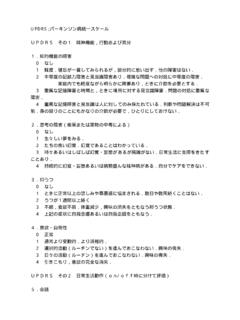Transcription of Accurate telemonitoring of Parkinson’s disease progression ...
1 1 Abstract Tracking parkinson 's disease (PD) symptom progression often uses the unified parkinson s disease Rating scale (UPDRS), which requires the patient's presence in clinic, and time-consuming physical examinations by trained medical staff. Thus, symptom monitoring is costly and logistically inconvenient for patient and clinical staff alike, also hindering recruitment for future large- scale clinical trials. Here, for the first time, we demonstrate rapid, remote replication of UPDRS assessment with clinically useful accuracy (about UPDRS points difference from the clinicians estimates), using only simple, self-administered, and non-invasive speech tests.
2 We characterize speech with signal processing algorithms, extracting clinically useful features of average PD progression . Subsequently, we select the most parsimonious model with a robust feature selection algorithm, and statistically map the selected subset of features to UPDRS using linear and nonlinear regression techniques, which include classical least squares and non-parametric classification and regression trees (CART). We verify our findings on the largest database of PD speech in existence (~6,000 recordings from 42 PD patients, recruited to a six-month, multi-centre trial).
3 These findings support the feasibility of frequent, remote and Accurate UPDRS tracking. This technology could play a key part in telemonitoring frameworks that enable large- scale clinical trials into novel PD treatments. Manuscript received July 30, 2009. Asterisk (*) indicates corresponding author. A. Tsanas is with the Systems Analysis Modelling and Prediction (SAMP) group, University of Oxford, Oxford, UK, OX1 3LB and with the Oxford Centre for Industrial and Applied Mathematics (OCIAM), University of Oxford, Oxford, UK. (phone: 0044 1865280603; fax: 0044 1865270515; e-mail: M. A. Little is with the SAMP group, University of Oxford, Oxford, UK, and with the OCIAM, University of Oxford, Oxford, UK P.)
4 E. McSharry is with the SAMP group, University of Oxford, Oxford, UK, and with the OCIAM, University of Oxford, Oxford, UK L. O. Ramig is with the Speech, Language, and Hearing Science, University of Colorado, Boulder, Colorado, USA, and with the National Center for Voice and Speech, Denver, Colorado, USA Copyright (c) 2008 IEEE. Personal use of this material is permitted. However, permission to use this material for any other purposes must be obtained from the IEEE by sending an email to Index Terms At-Home Testing Device, classification and regression trees, speech signal processing, telemedicine, unified parkinson s disease Rating scale (UPDRS) I.
5 INTRODUCTION E are aware of neurological control through muscle movement and sensing so early in life that is easy to take it for granted. However, neurological disorders affect people profoundly and claim lives at an epidemic rate worldwide. parkinson s disease (PD) is the second most common neurodegenerative disorder after Alzheimer s [1], and it is estimated that more than one million people in North America alone are affected [2]. Rajput et al. report that incidence rates have been approximately constant for the last 55 years, with 20/100,000 new cases every year [3].
6 A further estimated 20% of people with parkinson s (PWP) are never diagnosed [4]. Moreover, these statistics are expected to increase because worldwide the population is growing older [5]. In fact, all studies suggest age is the single most important risk factor for the onset of PD, which increases steeply after age fifty [6]. Although medication and surgical intervention can hold back the progression of the disease and alleviate some of the symptoms, there is no available cure [7], [8]. Thus, early diagnosis is critical in order to improve the patient s quality of life and to prolong it [9].
7 The etiology of PD is largely unknown, but the symptoms result from substantial dopaminergic neuron reduction, leading to dysfunction of the basal ganglia circuitry mediating motor and some cognitive abilities [8]. Parkinsonism exhibits similar PD-like symptoms, but these are caused by drugs or exposure to neurotoxins for example. The main symptoms of PD are tremor, rigidity and other general movement disorders. Of particular importance to this study, vocal impairment is also common [10], [11], with studies reporting 70-90% prevalence after the onset of the disease [11]-[13]. In addition, it may be one of the earliest indicators of the disease [14], [15], and 29% of patients consider it one of their greatest hindrances [13].
8 There is supporting evidence of degrading performance in voice with PD progression [14], [16], [17], with hypophonia (reduced voice volume) and dysphonia (breathiness, hoarseness or creakiness in the voice) typically preceding more generalized speech disorders [11], [12]. Management of PD typically involves the administration of physical examinations applying various empirical tests, including speech and voice tests, with a medical rater Accurate telemonitoring of parkinson s disease progression by non-invasive speech tests Athanasios Tsanas*, Max A. Little, Member, IEEE, Patrick E.
9 McSharry, Senior Member, IEEE, Lorraine O. Ramig 2subjectively assessing the subject s ability to perform a range of tasks. However, the necessity for the development of reliable, objective tools for assessing PD is manifested in the fact that current diagnosis is poor [2] and autopsy studies are reportedly inaccurate [18], [19]. Physical test observations are mapped to a metric specifically designed to follow disease progression , typically the unified parkinson s disease Rating scale (UPDRS), which reflects the presence and severity of symptoms (but does not quantify their underlying causes).
10 For untreated patients it spans the range 0-176, with 0 representing healthy state and 176 total disability, and consists of three sections: (1) Mentation, Behavior and Mood; (2) Activities of daily living; (3) Motor. The motor UPDRS ranges from 0-108, with 0 denoting symptom free and 108 severe motor impairment, and encompasses tasks such as speech, facial expression, tremor and rigidity. Speech has two explicit headings, and ranges between 0-8 with 8 being unintelligible. Noninvasive telemonitoring is an emerging option in general medical care, potentially affording reliable, cost-effective screening of PWP alleviating the burden of frequent and often inconvenient visits to the clinic.







